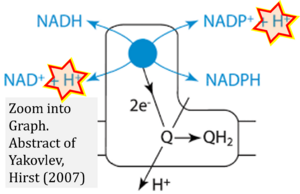Yakovlev 2007 Biochemistry
| Yakovlev G, Hirst J (2007) Transhydrogenation reactions catalyzed by mitochondrial NADH-ubiquinone oxidoreductase (Complex I). Biochemistry 46:14250-8. https://doi.org/10.1021/bi7017915 |
Yakovlev G, Hirst J (2007) Biochemistry
Abstract: NADH-ubiquinone oxidoreductase (complex I) is the first enzyme of the respiratory electron transport chain in mitochondria. It conserves the energy from NADH oxidation, coupled to ubiquinone reduction, as a proton motive force across the inner membrane. Complex I catalyzes NADPH oxidation, NAD+ reduction, and hydride transfers from reduced to oxidized nicotinamide nucleotides also. Here, we investigate the transhydrogenation reactions of complex I, using four different nucleotide pairs to encompass a range of reaction rates. Our experimental data are described accurately by a ping-pong mechanism with double substrate inhibition. Thus, we contend that complex I contains only one functional nucleotide binding site, in agreement with recent structural information, but in disagreement with previous mechanistic models which have suggested that two different binding sites are employed to catalyze the two half reactions. We apply the Michaelis-Menten equation to describe the productive states formed when the nucleotide and the active-site flavin mononucleotide have complementary oxidation states, and dissociation constants to describe the nonproductive states formed when they have the same oxidation state. Consequently, we derive kinetic and thermodynamic information about nucleotide binding and interconversion in complex I, relevant to understanding the mechanisms of coupled NADH oxidation and NAD+ reduction, and to understanding how superoxide formation by the reduced flavin is controlled. Finally, we discuss whether NADPH oxidation and/or transhydrogenation by complex I are physiologically relevant processes.
• Bioblast editor: Gnaiger E
Hydrogen ion ambiguities in the electron transfer system
Communicated by Gnaiger E (2023-10-08) last update 2023-11-10
- Electron (e-) transfer linked to hydrogen ion (hydron; H+) transfer is a fundamental concept in the field of bioenergetics, critical for understanding redox-coupled energy transformations.
- However, the current literature contains inconsistencies regarding H+ formation on the negative side of bioenergetic membranes, such as the matrix side of the mitochondrial inner membrane, when NADH is oxidized during oxidative phosphorylation (OXPHOS). Ambiguities arise when examining the oxidation of NADH by respiratory Complex I or succinate by Complex II.
- Oxidation of NADH or succinate involves a two-electron transfer of 2{H++e-} to FMN or FAD, respectively. Figures indicating a single electron e- transferred from NADH or succinate lack accuracy.
- The oxidized NAD+ is distinguished from NAD indicating nicotinamide adenine dinucleotide independent of oxidation state.
- NADH + H+ → NAD+ +2{H++e-} is the oxidation half-reaction in this H+-linked electron transfer represented as 2{H++e-} (Gnaiger 2023). Putative H+ formation shown as NADH → NAD+ + H+ conflicts with chemiosmotic coupling stoichiometries between H+ translocation across the coupling membrane and electron transfer to oxygen. Ensuring clarity in this complex field is imperative to tackle the apparent ambiguity crisis and prevent confusion, particularly in light of the increasing number of interdisciplinary publications on bioenergetics concerning diagnostic and clinical applications of OXPHOS analysis.



